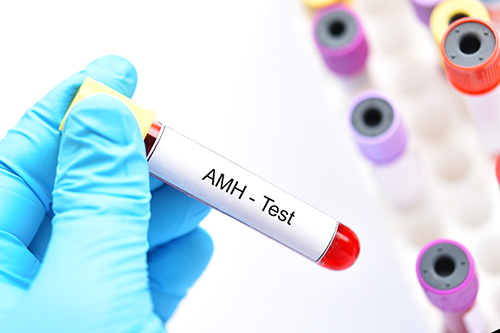The number of eggs in the ovary is referred to as the ovarian reserve. It is very important to make the distinction between egg numbers and egg quality. Ovarian reserve is often defined as both the number and quality of eggs in the ovary. However, because current tests can only estimate egg number, and egg quality will fluctuate from one egg to the next even within the same ovary, it is more practical to consider ovarian reserve in terms of egg number. Therefore, here I use the term ovarian reserve to refer to egg numbers.
Egg numbers are highest at birth (around 1-2 million) and, because no new eggs are made after birth, decline throughout life. At puberty egg numbers have declined to around 300,000 – 500,000 and by the time of the menopause, less than 1000 eggs remain.
What is AMH?
AMH stands for anti-Müllerian hormone. A woman’s AMH levels can be easily measured using a blood test.

AMH is important during the development of male foetuses for preventing a female-type reproductive tract from forming. In females, AMH is produced by ovarian follicular cells of particular stages of follicular development known as the preantral and small antral follicle stages (less than 8 mm). Therefore, the higher the number of preantral and small antral follicles there are in the ovary, the higher AMH levels will be. Because the numbers of preantral and antral follicles tend to reflect the overall number of follicles present in the ovary, AMH provides an indirect measure of the total pool of follicles and hence of eggs. This is not always the case, however, as some women have a smaller than expected pool of preantral and small antral follicle stages in comparison to their total follicular pool.
What is AMH used for?
AMH is most useful during IVF for predicting how the ovary is likely to respond to hormonal treatment with FSH. (For more information on IVF and FSH see my section on IVF/ICSI Treatment). This in turn will help to predict the numbers of eggs that may be retrieved at egg pick-up as well as give guidance on the dose of FSH to be used. In general, women with higher AMH levels require lower doses of FSH and will produce more eggs compared with women with very low AMH levels.
AMH has also been suggested to be able to predict fertility potential. However, AMH does not predict fertility potential, see section below on “Does AMH predict whether I can fall pregnant naturally?”
Another proposed use for AMH is to predict the time of the menopause. Again, studies do not clearly show that AMH is useful for this purpose. See my section on Menopause for more information.
AMH has also been linked with risk of miscarriage. Some studies suggest that very low AMH levels may be associated with a higher risk of miscarriage. The largest study on this issue did not find that AMH was linked with miscarriage. This year, the American College of Obstetricians & Gynaecologists concluded that “Routine antimüllerian hormone testing for prediction of pregnancy loss is not recommended”.
Does AMH predict my chances of falling pregnant with IVF?
Yes and no. This is because the most important determinant of pregnancy success is embryo quality, which is in turn heavily reliant on egg quality. Since AMH levels estimate egg numbers rather than egg quality, they do not strictly predict chances of pregnancy success.
But the answer is a bit more complicated than this. Although AMH levels do not strictly predict pregnancy success with IVF, higher AMH levels are nevertheless linked with better IVF outcomes for two main reasons. Firstly, AMH levels are highest in young women who also have the best quality eggs. Secondly, the higher egg numbers associated with a higher AMH level will increase the chances of finding at least one good-quality egg compared to women with very low AMH levels and egg numbers.
To put this in perspective, young women (late twenties and early thirties) with low AMH levels still have a good chance of pregnancy success with IVF because when egg quality is very good, only one or two eggs are needed to achieve success.

In contrast, women in their forties have a lower chance of success with IVF regardless of whether AMH levels are high or low due to poorer overall egg quality.

However, for women in the older age-range, high AMH levels will improve chances, since more eggs can be obtained thereby increasing the chances of finding one with good-quality.
Does AMH predict whether I can fall pregnant naturally?
The answer is NO.
It is important to highlight the difference between falling pregnant naturally (this refers to women who have no known fertility problems) and falling pregnant during IVF treatment (these are women with known fertility problems). AMH is most useful for predicting how ovaries will respond to FSH stimulation in the latter group of women but is not useful for predicting likelihood of pregnancy in the former (non-IVF) group.
Several studies, including one published in 2017 in one of the world’s top journals, JAMA, have investigated whether AMH levels could predict chances of natural fertility. These studies have not found any association between AMH levels and the chance of achieving a pregnancy. Based on the results from these studies, therefore, the level of a woman’s AMH cannot predict her chances of achieving a pregnancy naturally.
This year, the American College of Obstetricians & Gynaecologists concluded that AMH is not able to predict natural fertility potential and that it “should not be used for counselling patients in this regard”.
Doctors should be very careful about mis-interpreting the meaning of an isolated AMH value. Women should consult with experts in the field who can properly evaluate all of the relevant information.
Are there other measures of ovarian reserve?
A transvaginal ultrasound scan performed during the early part of the menstrual cycle can be used to assess ovarian reserve. This scan is used to count the total number of small antral follicles present in both ovaries. This count is known as an antral follicle count (AFC) and provides an indirect measure of the total follicular pool in the ovaries. For more information on ovarian follicles and antral follicles, see my section on The Menstrual Cycle and Ovulation Tracking.
Other markers have been used to estimate ovarian reserve including blood tests for measuring the levels of FSH and inhibin B. However, AMH and antral follicle counts are the two best tests available.
What is the egg timer test?
This test aims to estimate the numbers of ovarian follicles and eggs present in the ovary at a given time. Some people consider that an AMH test alone is enough. For the reasons explained above, it can be misleading to use AMH values alone to estimate egg numbers. A more comprehensive evaluation involves an AMH test as well as an ultrasound scan performed by a highly trained fertility expert to measure the antral follicle count. For the reasons detailed in the above sections, the egg timer test can estimate egg numbers but is not a reliable predictor of fertility potential.
Who should I see to assess my ovarian reserve and fertility potential?
It is important to obtain a balanced and impartial interpretation of all the facts contributing to your fertility. Based on what I have written above, this requires consultation with a highly trained expert with in-depth knowledge of ovarian biology, knowledge of what tests like AMH and AFC actually measure, as well as their limitations. Women should not be misled into thinking that a low AMH value necessarily spells disaster for fertility prospects or that they must immediately take drastic measures such as undergo IVF to freeze eggs.
Prof Homer is an international expert in ovarian biology and egg quality as well as one of Australia’s leading egg researchers. He set up Queensland’s first research laboratory dedicated to studying ovarian biology and egg quality, and to developing novel treatments for improving egg quality. Prof Homer is also the only specialist in Queensland who has been clinically accredited at the highest level in Reproductive Endocrinology and Infertility both in Australia (CREI) and in the UK (CCSST).
